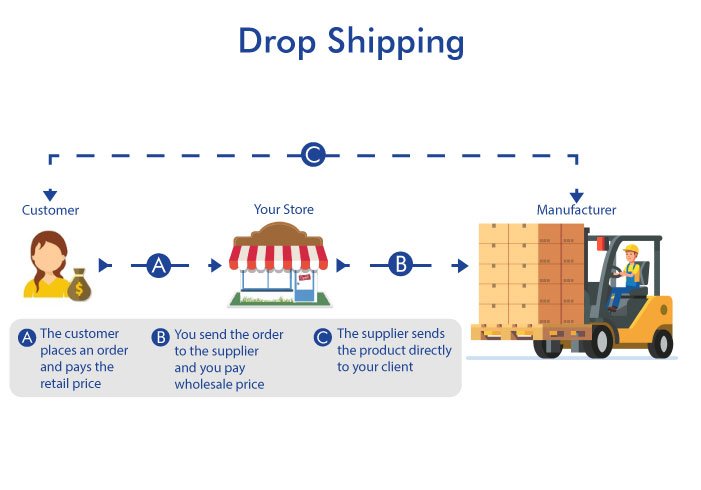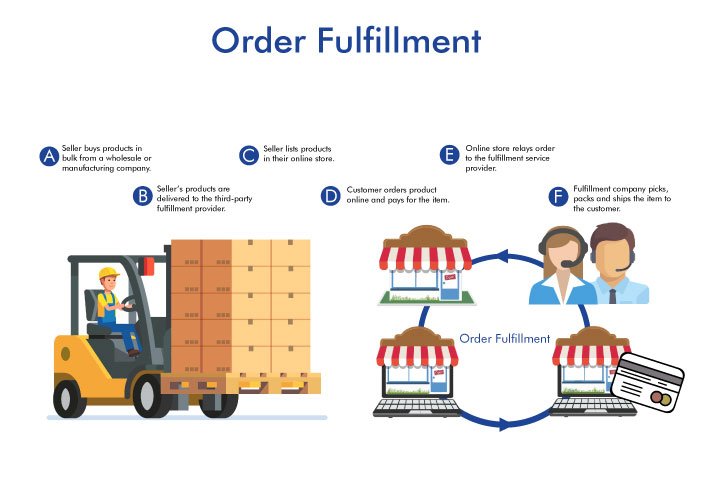Drop Shipping vs. Third-Party Fulfillment: Which Is Right for You?

There are two types of drop shipping, wholesale, and retail.
Wholesale is the sale of large quantities of goods to a retailer or other business at a price set by the manufacturer, sometimes with discounts for buying in bulk.
Retail is when an entrepreneur sells small quantities of goods directly to consumers at prices, they set themselves.
Third-party fulfillment is also known as drop-shipping, in which an entrepreneur sends their inventory to a warehouse and then has it shipped out through third-party logistics providers such as UPS or FedEx. They offer fulfillment services for e-commerce companies.
Third-party fulfillment has become more popular than drop shipping because it offers more flexibility in terms of what can be sold and how much inventory must be on hand.
The critical difference between these two models is that third-party fulfillment does not require any upfront capital investment from the entrepreneur.
Drop Shipping:

Drop Shipping is a business model in which the retailer does not keep goods in stock but instead sends orders to the manufacturer or distributor, who then ships them directly to the customer.
In this fulfillment procedure, the online retailer teams up with a manufacturer that will ship the items straight to customers to sell their merchandise, which has not yet been purchased by the retailer or added to inventory. In other words, they outsource while also removing all the typical intermediaries.
Budgets can benefit from outsourcing in the short term since business owners won’t have to spend money on maintaining inventories. However, manufacturers gain from this arrangement over time since they may satisfy orders rather than deliver to the wholesaler by charging the seller a higher wholesale price for the goods. Instead of managing goods transport or storage, the eCommerce seller now takes care of marketing.
This technique may be a tremendous logistical solution for those who lack the resources to buy their inventory or do not want to spend and deal with the pain of storage and fulfillment. Although it’s not the most fantastic option for every organization, this frequently turns into excellent efficiency. It offers several benefits and drawbacks, just like any other choice. For instance:
Pros
Helps a firm get out and run more cheaply: Unlike a regular eCommerce business, which could need you to buy inventory upfront, drop-shipping takes less capital to get started.
No requirement for warehouse space: You won’t have to worry about storage space because you won’t have to transport any merchandise yourself. It helps if you’re starting and don’t have much additional room in your house or business.
It’s simple to start: Drop-shipping fulfillment is an excellent choice for individuals just starting their eCommerce adventure because it is reasonably simple to set up. You only need a platform to sell on and a provider, like Shopify.
It provides you more freedom to test products: This means that you can quickly and cheaply find out if a product is worth the commitment of a large inventory order. This way, if they don’t sell well, you’re not stuck with an abundance of stock that no one wants to buy.
SKU breadth can be increased: You may enhance sales by attracting more customers by providing more items. Drop shipping may increase your product selection without raising your inventory.
It permits greater risk and a greater reward for developing unproven products: Drop-shipping fulfillment is a low-risk method of trying out new goods. If the product fails, you won’t be stuck with a ton of unsold inventory. However, you may make much money without having to make a sizable upfront investment if it is a success.
Cons
You have less influence on how well-made a product is: You depend on your supplier to provide high-quality goods when you drop ship. If they don’t, your company will suffer as a result. It may be annoying and result in bad ratings and client turnover.
It can be not easy to establish a brand: Establishing a solid brand identity might be challenging when you don’t carry any merchandise. If you frequently change your goods, customers might not think of your company as a go-to supplier for certain things. Drop shippers frequently use suppliers from other countries. More extended shipment periods may result in irritating consumers and generating lousy feedback. Possible lengthier shipment timeframes are as follows:
You could have to handle more difficulties with customer service: You are responsible for addressing any customer service issues that arise when an order is incorrect. Dealing with demanding or irate consumers may make it time-consuming and irritating.
Third-Party Order Fulfillment:

Third-party fulfillment is a business model in which a company sells its products to other companies, distributing them to customers. This business model is typically seen in the retail industry and is commonly used by companies with extensive stock inventories.
The name tells you what to expect—third-party fulfillment. 3PL, essentially an outsourced fulfillment strategy where you hire a service provider to handle the logistics of delivering to consumers, collecting, and packing orders, and storing items, relieves stress and in-house engagement while cutting shipping costs.
It appears to be the seller stocking up on products in large quantities and contracting with a warehouse to handle the burden of order fulfillment in general.
It makes it a more appealing choice for merchants who do not want to lose goods, even if they lack storage. When clients click “purchase,” all the e-Commerce seller needs to do is display the items online and get in touch with the fulfillment provider to complete order processing.
For those with the resources for inventory maintenance but who don’t want to handle everything in-house, a 3PL provider is an excellent option because they will take the remainder of the job, including product collection, packing, and delivery.
It does, however, work for some people and not for others, much like drop-shipping. Among the advantages and disadvantages are:
Pros
Enables active participation in your inventory: Like drop-shipping fulfillment, you may verify the items before they are sent to your consumers, so you don’t have to worry about their quality.
You can provide unique packaging: For many luxury brands, this is a crucial one. Presenting items in high-quality packaging that shows you care about the unpacking experience helps to boost customer loyalty and order value.
Reduces issues about product quality: Again, since you have control over what goes into storage, it is less likely that your consumers would receive faulty or subpar goods.
It provides fast shipping: Utilizing a fulfillment business close to your target market might result in quicker shipment times and enhanced customer satisfaction. Companies that offer perishable goods or commodities with a short shelf life should pay extra attention to this.
Because storage costs are erratic, there may be substantial long-term savings: Particularly for organizations that encounter seasonal swings in inventory levels, it can result in considerable long-term savings. 3PL suppliers usually only charge for the space your items use, unlike drop-shipping, where you are paid for storage whether you utilize it.
Cons
Occasionally restrict the range of products available: You might not be able to provide as many things as you’d want since you must buy inventory in large quantities. It could make it harder for you to profit from emerging trends or changes in seasonal demand.
Connects your capital and inventory directly: You are left with the list and the accompanying storage fees if your items don’t sell. Your company may have a significant cash loss, especially if you must sell off sluggish-moving products at a deep discount.
While 3PL handles fulfillment, you are still in charge of all inventory management: Preventing damage and spoiling entails ensuring that products are kept and cycled appropriately. It also involves keeping an eye on stock levels to avoid overselling. Whether you view this as a pro or a drawback depends on your perspective, but it’s important to note that you are still managing your inventory levels.
Which Alternative Is Best for Your Business:
It must be clear that third-party fulfillment and drop-shipping may improve your company in distinct ways. Before settling on one option, knowing all the facts for each is essential. Every logistics solution will operate differently for you since every firm is unique.
While the right choice for any business depends on its specific needs, there are four primary considerations to take into account:
- Business Model:
Your business model will determine many of the logistics you need to consider. Drop shipping tends to be a more cost-effective solution for smaller businesses with fewer orders, while larger enterprises typically benefit from the scalability. The right choice for you depends on the size and scope of your business.
- Cost:
Drop shipping may be the way to go if you want the most affordable option. On the other hand, if you’re looking for the most reliable and efficient option, third-party fulfillment might be the better choice.
- Speed and Efficiency:
With drop shipping, you have complete control of the order process and can ensure orders are shipped quickly and efficiently. The provider can handle the entire process for you, and they may have improved methods and systems to make the process even faster and more efficient.
- Inventory Management:
You’ll need to manage your inventory and handle all the tasks with drop shipping. With third-party fulfillment, the provider will typically collect your list.
Conclusion:
Drop-shipping fulfillment and third-party fulfillment are two excellent choices when considering outsourcing order fulfillment. I think it’s good to weigh the pros and cons before making your final decision. The business requirements will ultimately determine your best course of action.
Drop shipping is a form of e-commerce that allows entrepreneurs to sell products without having to keep inventory. Third-party fulfillment is a form of e-commerce that will enable entrepreneurs to sell products without having to keep any list.
This section concludes that drop shipping and third-party fulfillment are different, but both have advantages and disadvantages. Ultimately, it depends on the entrepreneur’s needs.